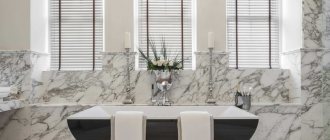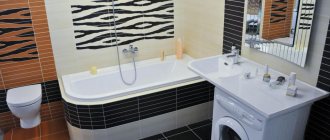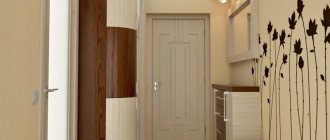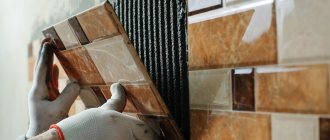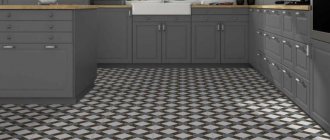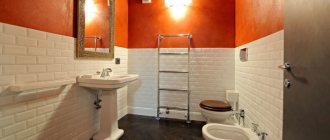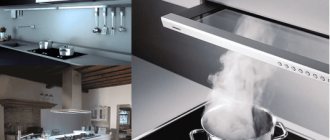For a small bathroom, tiles of small size, light color, smooth or low-relief texture are ideal. A smooth surface of finishing material is better suited for the floor. Textured and embossed materials are allowed on the walls. The shape of each tile is not important in the choice. Each unit can be square, rectangular, triangular, hexagonal. If the room is narrow, then you can visually expand it with the help of light tiles and panel edging - narrow tiles of a contrasting color.
Medium-sized tiles in the shape of a honeycomb in gray color suit a Scandi bathroom Source sun9-74.userapi.com
Tile color range
For a small room, designers recommend using the following shades:
- Neutral (graphite, purple, white);
- Warm (sand, yellow, apricot);
- Cold (sapphire, cornflower blue, olive).
It is advisable to avoid combinations of warm and cold colors. It is better to complement a rich palette with neutral tones. This solution is considered optimal for a modest-sized bathroom.
Optimal combinations
If you want to decorate a small bathroom with two-color tiles, you need to choose elements that do not contrast, but complement each other. The main thing is the predominance of light shades. Winning combinations:
- blue with light blue;
- pink with soft purple;
- beige with ivory.
Pink with soft purple - as one of the options in the interior
To combine bright and unusual shades on a light background, the following combination options:
- blue and yellow;
- muted orange and dark lilac.
Muted orange and purple in the bathroom interior
A small pattern on elements of a contrasting shade will add sophistication and grace to the design.
It is better to decorate miniature bathrooms in two shades of the same color. Shade to visually increase the size and geometry of the space. Short walls are tiled with lighter tiles, long walls are tiled a tone darker.
Neutral background and burgundy shade
The burgundy shade will fit perfectly into a classic-style interior. It is also suitable for such styles as Baroque and Art Nouveau. The use of such a color scheme requires compliance with proportions and the addition of neutral colors. Gold-plated and bronze elements are appropriate in the design.
Traditional combinations are combinations of burgundy with white and milky tones. It is allowed to use tiles with an elegant gold pattern.
Floor marking
Before marking, it is recommended to make a detailed plan, and on its basis it will be excellent to mark the floor plane. All marking strips must come out even, this prevents unevenness and distortions during finishing; here you can use a laser level.
Before gluing the tiles, it is recommended to lay them out as planned to check the straightness of the lines and the correctness of the laying plan. It is better not to ignore this step, since if any defects occur, the technician will have 20 minutes to correct them.
Pastel tile colors
Pastel is considered a winning option in the case of a modest-sized bathroom. Moreover, shades of both cold and warm spectrum are allowed in the decoration. Muted colors allow you to visually increase the volume of the room.
Without delicate colors it is impossible to imagine a whole range of styles:
- Country;
- Provence;
- Minimalism;
- Vintage.
For a neutral palette, it is recommended to create color accents (ultramarine, coral), organize additional lighting above the sink, in the shower stall.
Laying scheme
The visual perception of the bathroom space depends not only on the type of tile, its color or texture, but also on the method of its installation. Correct application of the laws of design will create the effect of spaciousness, even in a small area:
- traditional installation method without crossing seams. Laying is carried out at right angles without displacement of elements. This option is perfect for installing tiles of various colors in a small room;
- if it was decided to choose a single-color material for the bathroom, designers recommend laying it offset along the horizontal seam by half of the tile;
- Diagonal laying will help increase the volume of a small room, but to install such a finish you will need an experienced craftsman, and besides, after completing such work there are a lot of tile scraps left.
For the traditional direct installation method, you should purchase rectangular tiles and place them vertically. If the room is long and narrow, it is better to lay such tiles horizontally.
Bright tile colors
The use of bright colors in the design of a small room requires a neutral background. A popular idea is to highlight one of the walls with a rich color (peach, purple, green). Terracotta tiles with the addition of pistachio and milk blocks look unusual.
The best complement for an orange color scheme is a green, ash, dark blue palette. High-tech welcomes the combination of bright orange and boiling white.
Texture
In addition to white, only 1 tile can be made without texture - imitation marble. It suits both modern and classic bathroom design styles. But the main thing to understand is that marble is a risky option. It is difficult to formalize which marble tiles are good. Therefore, we look at specific examples. Very poor marble imitation:
Normal:
Cool:
There is a thin line between good and bad marble tiles, if you are not sure, choose something else.
To imitate all other materials, in addition to the pattern, the texture must also be conveyed. On stands this is usually not felt as much as after installation. Photos on the Internet also convey the texture very poorly. Everything needs to be seen live and definitely touched with your hands.
The hottest tile designs in 2022 are concrete and wood. The former look very cool in a matte finish (but matte is more expensive), and wood with a deep texture. Because the concrete is gray and uneven, even if there is no texture it is very practical and water stains are not visible on it. Let's look at the options for gray cladding in real photos.
Expensive matte concrete tiles:
Average price ($11/m2) gray tiles without texture from that bathroom with a shower from the 1st part:
And several economy class options from Belarusian:
Popular shades for a small bathroom
The most popular shades for a small room are cream, golden, pearl. Experts advise highlighting delicate finishes with tiles with relief patterns or subtle patterns.
Blocks with a rough texture that imitates wood or stone are suitable as an accent. You can use tiles decorated using the decoupage technique.
Preliminary issues to consider
Preparation begins with calculating the number of tiles for the walls and separately for the floors. If the tiles are assumed to be monochromatic, it will be easier and faster to calculate the tiles.
If you want to decorate the bathroom in a certain style, make a drawing, draw a patterned edging around the perimeter or lay out screens, you should approach the calculations more carefully. Here it would be more correct to first draw a layout diagram.
To calculate the consumption of tiles, first calculate the area of the base. Vertical and horizontal structures require the following calculations and related points:
Determine the length and height of the walls and multiply the resulting values. The area of the doorway is subtracted from the resulting number.
Decorating bathroom walls with tiles can be done either completely or selectively. Some areas that are hidden by plumbing may not need to be repaired.
This is usually done in small apartments, where the bathrooms are so small in volume that dismantling the equipment becomes unprofitable (unless a complete replacement of the bathtub is planned). In wide bathroom spaces, dismantling and rearranging is easier.
Floors are calculated by length and width. The area of the lower horizontal base is much smaller than the walls, but here it is worth taking into account the piping and installation of the bath itself.
For many, it is enough to bring the floor tiles to the edge of the bathtub, and then install a wide vertical screen covering its side part.
We recommend reading:
- Washing machine in a small bathroom under the sink: ranking of the best in 2022
- Bathroom with a window: rules and real photos of successful interior solutions in 2022
- Gray bathroom design: pros and cons, combinations of gray with other colors
The screen can be purchased ready-made (a panel with imitation tiles) or installed manually. Typically, brickwork or sheets of moisture-resistant plasterboard are used, followed by cladding.
Classic colors
Classic colors are used in traditionally designed bathrooms. The interior looks interesting in a brown color scheme with the addition of a shade of ivory. Monochrome slabs and imitations of natural wood are popular in the design.
Using pale green tones combined with gray or white helps bring harmony to a classic setting. The blue palette is complemented by metallic and white shades, which visually expands the area.
Style
To choose tiles for a bathroom with a small area, choose a design that is not pretentious. The best options are:
- Scandinavian;
- Modern;
- East;
- High tech.
They are more minimalistic and do not clutter up the space. Moreover, these styles often have cold but beautiful tile colors.
Tile sizes for a small bathroom
Due to the visibility of the grout, large slabs are inappropriate in a small room. Glazed parts, even in light colors, should also be abandoned. They have the property of visually reducing space.
- The ideal tile should be small or medium sized.
- Large monochrome blocks in the shape of a square are allowed.
- But they should be complemented with small tiles of a contrasting tone. In this case, the seams will not be noticeable.
- Another possible option is to combine square slabs with rectangular border pieces.
- An unpretentious pattern in the corners of the squares will make the seams invisible.
A tile that is too small is a bad idea - it will visually make the room smaller, especially in combination with colored grout.
What type of surface to choose: glossy or matte?
Any coating is suitable for a small bathroom, but each has its own characteristics:
| Glossy | Matte |
| Visually increases the area of the room, giving depth. | Used in interiors where gloss is inappropriate. |
| Shiny tiles reflect light, expanding the space. Suitable for walls. | The rough texture of ceramic tiles is safer and therefore suitable for floor coverings. |
| Water drops and handprints are more noticeable on it, but the surface is easy to clean. | On a matte finish, plaque is less noticeable, but it is also more difficult to wash. |
Since the purpose of decorating a small bathroom is to expand the space, glossy products are preferable.
The photo shows a glossy “hog” that adds depth to the space in a small bathroom.
Bathroom tile design
Here are a few rules that will allow you to choose the right material for finishing a small bathroom:
- Small patterns invariably look advantageous in a room of modest dimensions.
- A single panel in bright color is an excellent option for a room whose space is limited. This interior detail should contrast with the main background and be compact.
- Small colored tiles in a monochrome palette are an ideal solution if you need to create a mosaic picture in a shower stall.
Bathroom tiles can be laid:
- Seam to seam;
- Diagonal;
- In the dressing;
- Modules;
- Mosaic;
- Ladder.
What tile shape should I choose?
Today, the modern building materials market offers a large selection of finishing decor, which differs in shape, size and installation method. However, not all models of small tiles are suitable for use in the bathroom. Let's take a closer look at this situation.
Standard products in rectangular or square shapes are designed to emphasize geometry. Outwardly, they seem not intrusive, which is what is necessary for small spaces. However, such decor will become boring over time.
Walls decorated with voluminous and relief tiles look unusual and impressive. When visiting the space of a relaxation zone, the first thing that catches your eye is these details. Do not overload the room with such decor.
It is enough to highlight the central wall above the bathtub or the mirror area. Tile models with unusual shapes in the form of scales or triangles should also be chosen to highlight certain areas.
Additional recommendations
Experts in the field of interior design advise paying attention to professional aspects. The class of the tile is of great importance. If it is expected that the room will be rarely used, then it is rational to choose 1st class tiles.
For rooms that are constantly in use, it is better to choose class 2. This finish will last much longer.
Expert recommendations:
- The material should be laid on the surface for which it is intended. Blocks with different purposes have different loads.
- Before starting facing work, it is necessary to level the walls and floor. Laying work requires a perfectly level base.
- It is better to choose grout to match the tile.
- Mosaic tiles should be in light, least contrasting colors. This way there will be no effect of volumetric variegation.
- The white palette requires careful use. An abundance of white colors can create a hospital atmosphere.
- If there is not enough light in the room, the best solution would be to choose light-colored tiles. If the space is well lit, a rich but not dark color scheme will do.
Buying tiles for a small bathroom is a matter that requires a responsible approach. The right choice will add space and freshness to the room, and also give a feeling of freedom.
How to prepare the base
To prepare the base for laying ceramic products, you need to do the following:
- Waterproofing of the base is created. This step is done before pouring the wet screed or self-leveling compounds, so that the liquid from the mixture does not go down. The waterproofing layer is done only to prevent leaking liquid from spoiling the repairs for the neighbors;
- Leveling can be done when the level difference does not exceed 10 mm per 1 meter, because the tiles require a level base. Laying tiles on a thicker layer of adhesive leads to a violation of the technology. A separate bag describes the thickest thickness of adhesive that can be used for repair work;
Applying primer to the surface. A necessary step, which, in addition to reducing absorbent properties, increases the adhesion of the adhesive and removes dust from the surface.
Photo of tiles for a small bathroom
Mosaic – space for decoration
For multi-color solutions, it is preferable to use mosaic. It is better to have a single color or neutral color scheme. For its production, ceramics with a porous structure, glass, smalt, and less often metal are used. And for floor coverings - granite, marble, and sometimes jasper.
Mosaic elements for multi-color solutions
Miniature size is the advantage of this cladding material. It allows you to lay mosaics in hard-to-reach places, for example, in rounded shapes. This is a definite plus for decorating a small bathroom, where there are a lot of fancy curves.
The advantage of mosaic is its small size
Dignity comes in many forms. The multi-angle format expands creativity and goes well with tiles.
Mosaic accents add sophistication and originality to the decor. Many mosaic ornaments created in past centuries have survived to this day, which testifies to the durability of such cladding.
Mosaic as an accent
Ready-made mosaic blocks with different patterns are sold. This saves time on installation.

